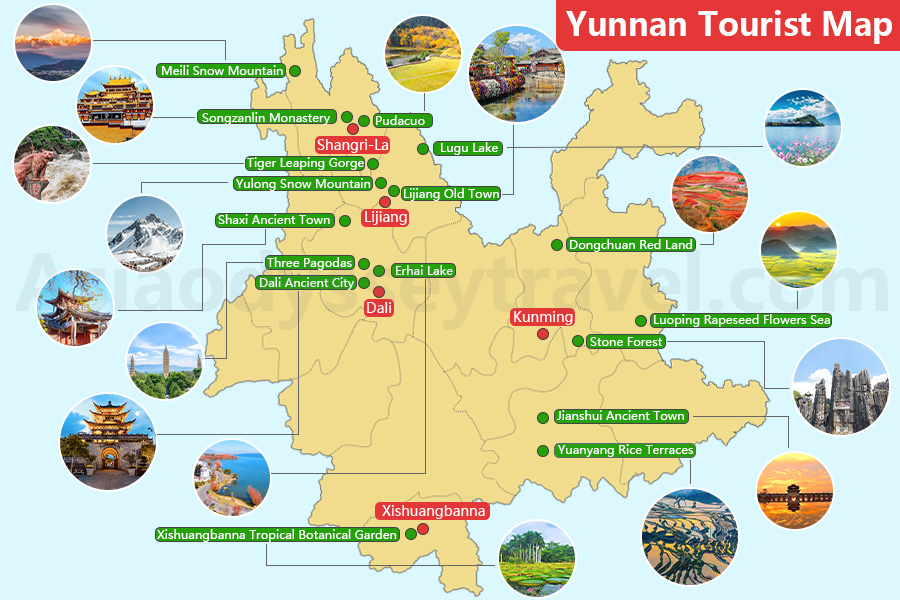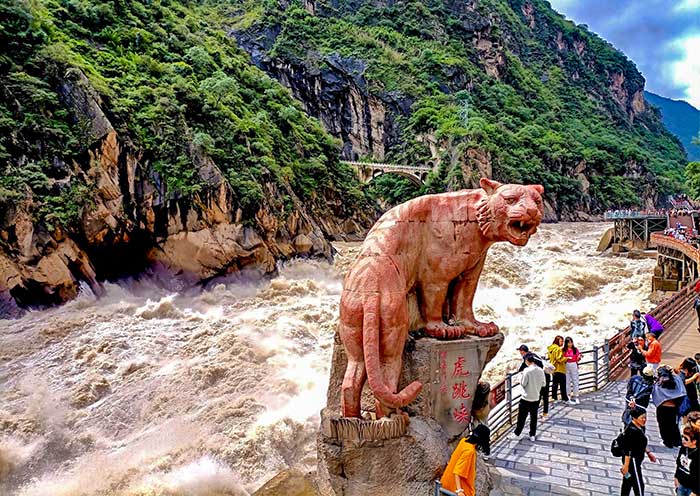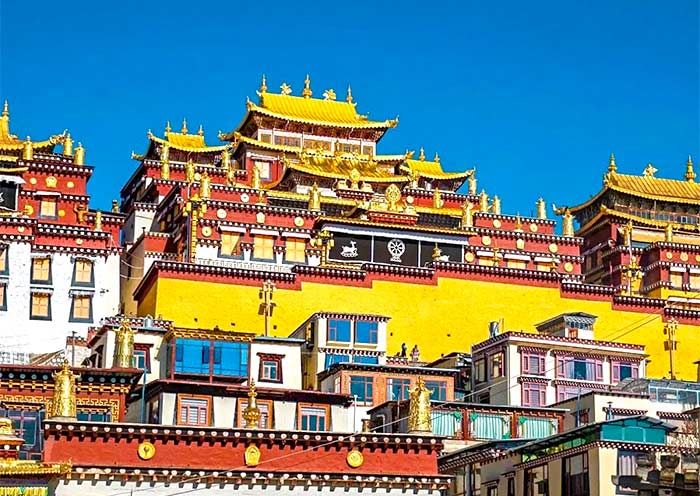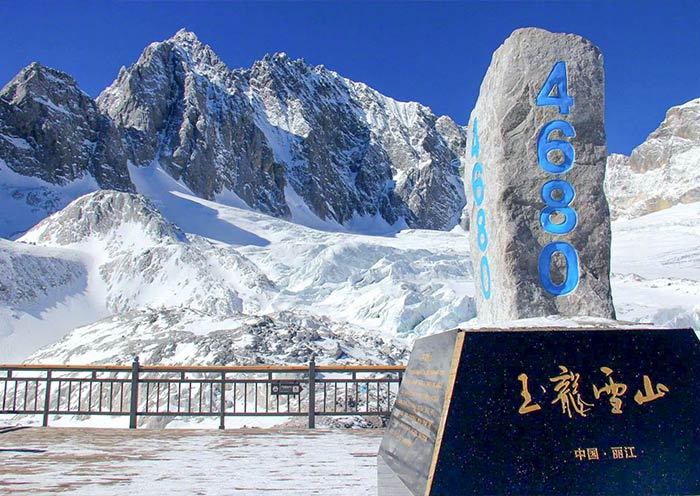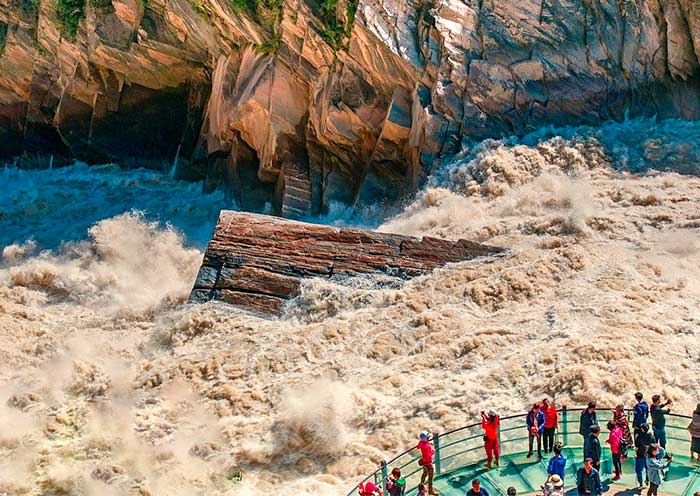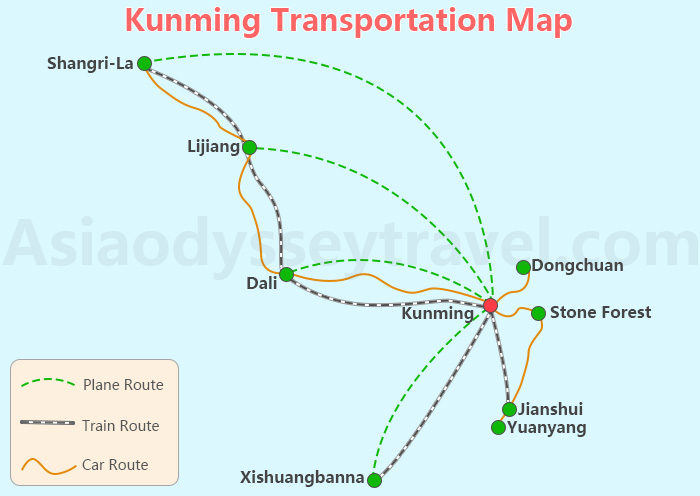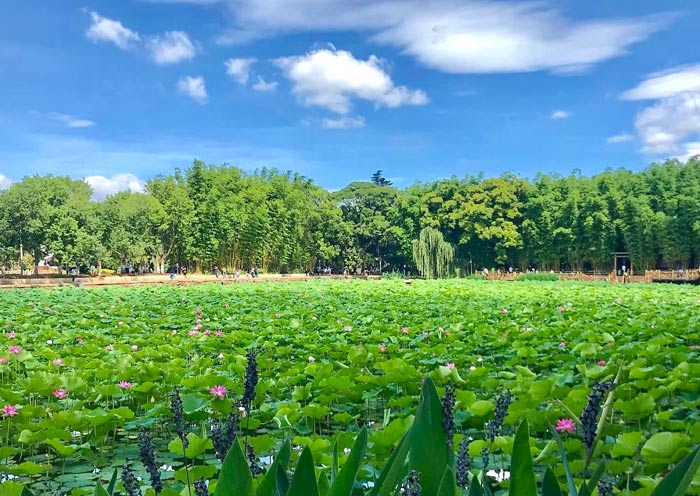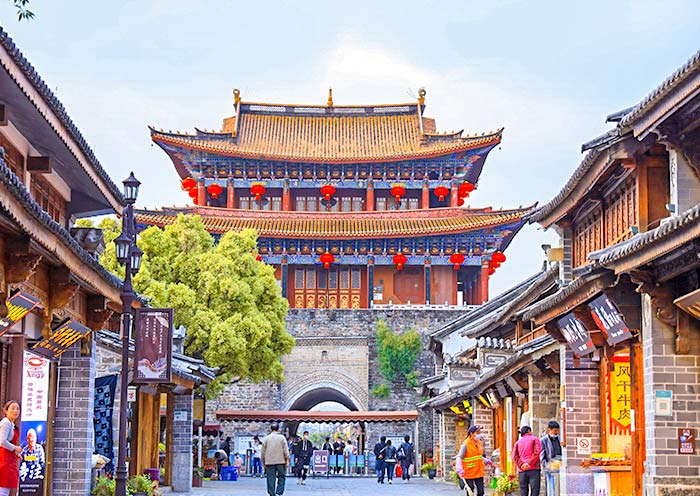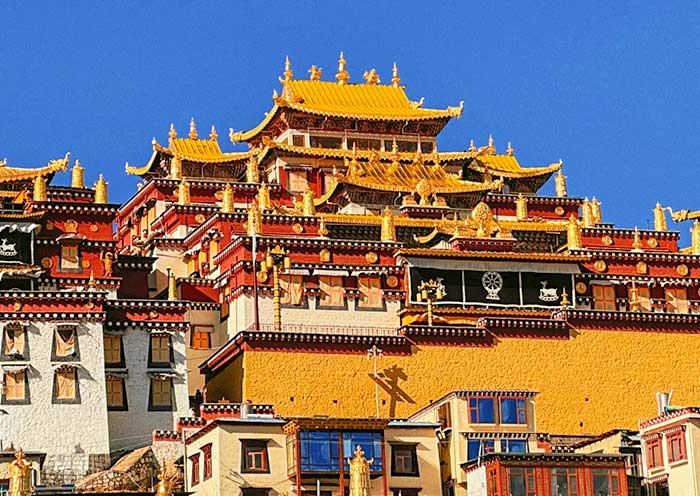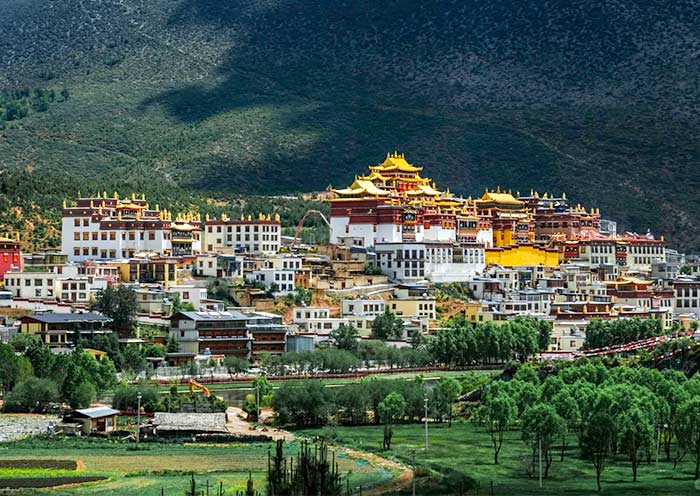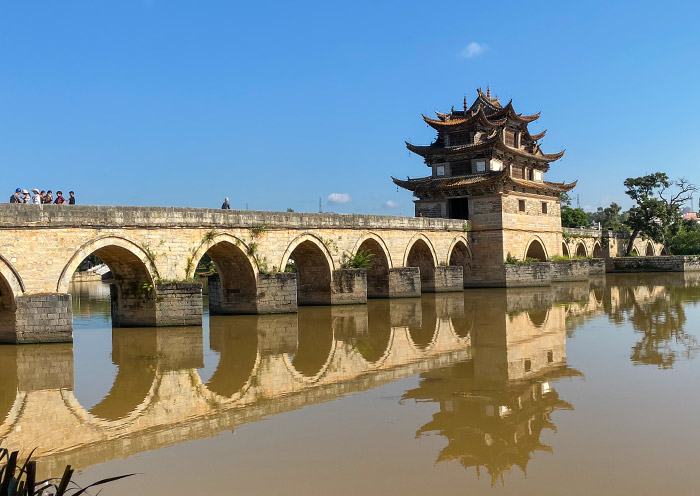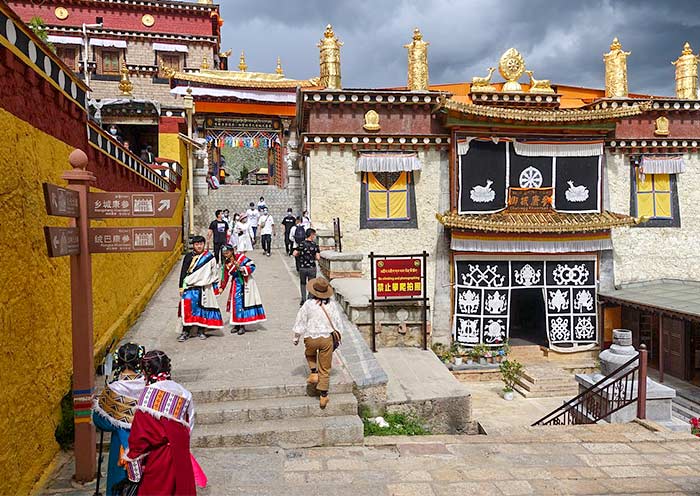Map of Shangri-La Yunnan Attractions
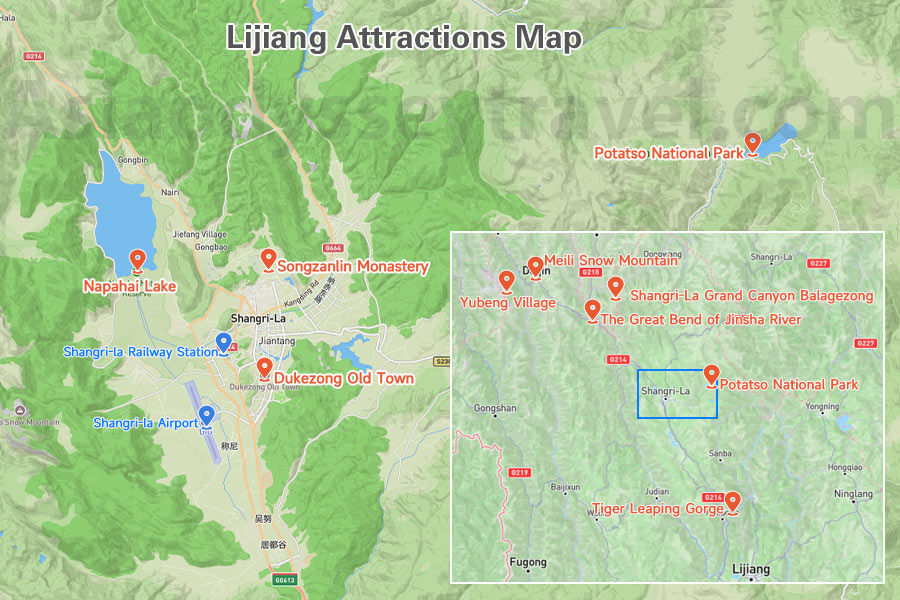
1. Songzanlin Monastery - Iconic Attraction in Shangri-La
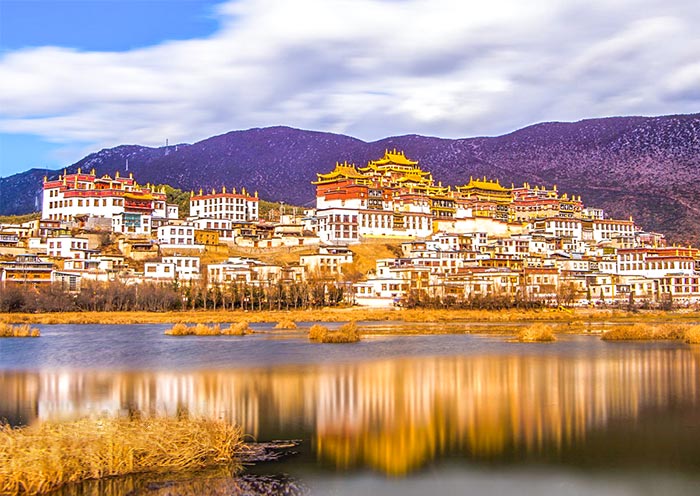
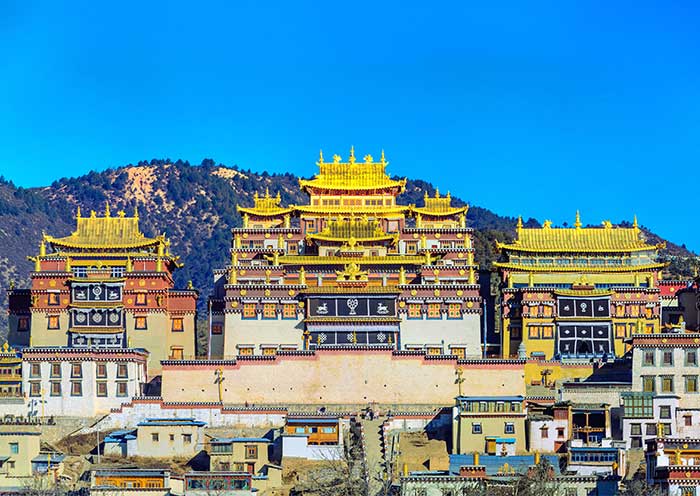
Songzanlin Monastery, also known as Ganden Sumtseling Monastery (噶丹·松赞林寺), Sumtsaling Monastery, or Guihua Temple(归化寺), is located just 6 kilometers away from central Shangri-La city. It’s the largest Tibetan Buddhist monastery in Yunnan Province and is often referred to as the "Little Potala Palace" due to its resemblance to the Potala Palace in Lhasa, Tibet. The monastery was built in the 17th century and is a crown jewel of Shangri-La and a must-see attraction for anyone interested in Tibetan culture and history.
Top Attractions of Songzanglin Monastery
- The three tallest and most eye-catching buildings are Dratsang Hall, Master Tsongkhapa Hall, and Sakyamuni Hall, which are a must-visit in Songzanlin Monastery.
- There are 147 straight steps connecting the temple gate (ticket office entrance) and the tallest building, Dratsang Hall. Climbing these steps seems to be a mandatory course for visiting Buddhist temples.
- Outside the monastery, there is a small lake called Lamuyangcuo Lake. A half-hour walk around the lake provides different angles to admire Songzanlin Monastery and capture panoramic photos and reflections in the lake.
2. Dukezong Ancient Town - Antique Shangri-La Old City
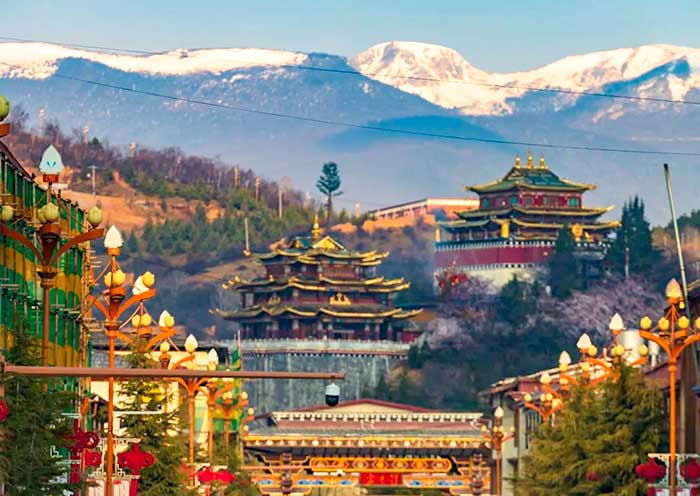
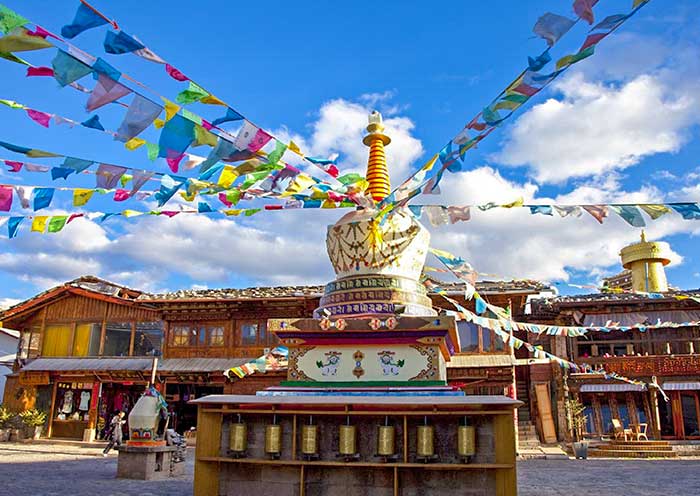
Dukezong Ancient Town, also known as Dukezong Old Town, is located at the foot of Shika Snow Mountain in Shangri-La with a history of over 1,300 years. It is considered one of the oldest and best-preserved Tibetan towns in China and is known for its rich Tibetan culture and unique architectural style. The town's name, "Dukezong," means "City of Moon" in the Tibetan language. The town is characterized by its traditional Tibetan architecture, with narrow cobblestone streets, white-walled buildings, and prayer flags fluttering in the wind.
Things to Do in Dukezong Ancient Town
- Guishan Park(龟山公园): Located at the center of Dukezong, Guishan Park features the Guishan Tibetan Buddhist Temple, offering panoramic views of the town. Don't miss the world's largest golden prayer wheel, a must-visit attraction in the old town.
- Yueguang Plaza (月光广场): Adjacent to Guishan Park, Yueguang Plaza is a gathering place for local Tibetans. In the evenings, you can witness traditional Tibetan dance performances, such as the Guozhuang dance. Feel free to join in and experience the vibrant local culture.
- Explore the charming streets: Take a stroll through the maze-like streets of Dukezong, lined with shops selling Tibetan handicrafts, local artworks, and traditional Tibetan medicines. Discover unique souvenirs and immerse yourself in the rich cultural heritage of the region.
3. Potatso National Park - First National Park in China
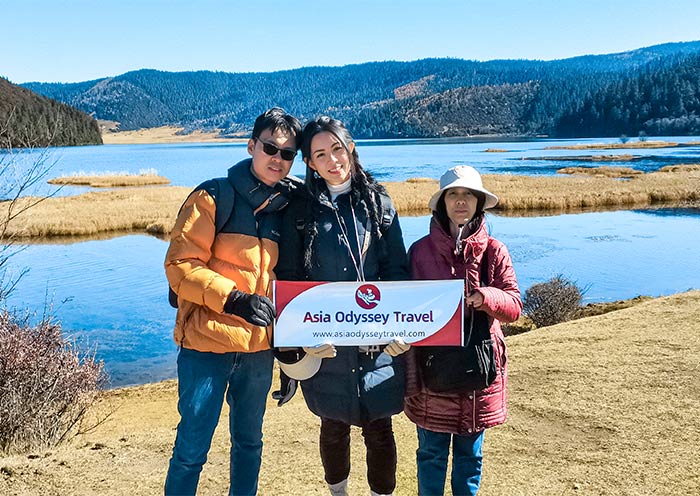
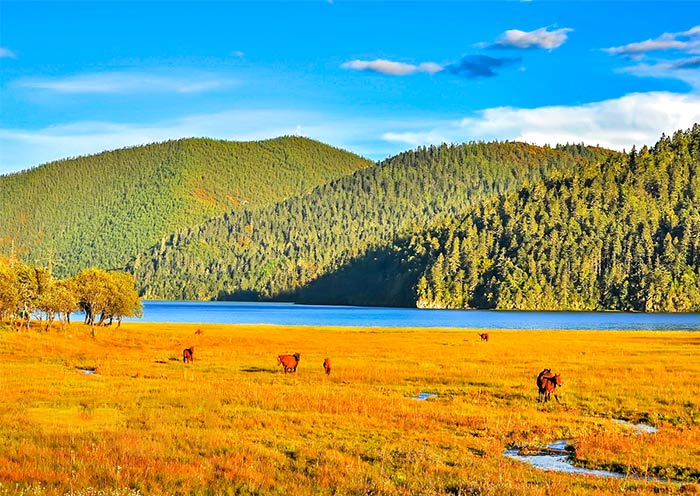
Potatso National Park, also known as Pudacuo National Park, is a stunning natural reserve located 30 kilometers west away from Shangri-La city. It is part of the Three Parallel Rivers UNESCO World Heritage Site and is renowned for its breathtaking landscapes, pristine lakes, and diverse ecosystems.
Covering an area of approximately 1,300 square kilometers, Potatso National Park is characterized by its lush forests, alpine meadows, and crystal-clear lakes.
Attractions & Things to Do in Potatso National Park
- Trekking to Shudu Lake (属都湖): This picturesque lake is the largest in the national park and is surrounded by dense forests and snow-capped peaks. You can enjoy walking trails (2.2km) and boat rides to explore the serene beauty of the lake.
- Visiting Bita Lake (碧塔海): Known for its turquoise-blue waters, Bita Lake is considered one of the most beautiful alpine lakes in China. It is surrounded by dense forests and is an important habitat for various plant and animal species.
- Militang Grassland(弥里塘高山草甸): Located at an elevation of over 3,000 meters, this vast grassland offers stunning panoramic views of the surrounding mountains and valleys. It is an ideal spot for hiking, picnicking, and enjoying the fresh mountain air.
- Luorong Pasture(洛茸牧场): This pastoral area is dotted with yaks, Tibetan-style cottages, and colorful prayer flags. It provides a glimpse into the traditional Tibetan way of life and offers visitors a chance to experience the local culture.
4. Tiger Leaping Gorge - Adventure in the Cracks
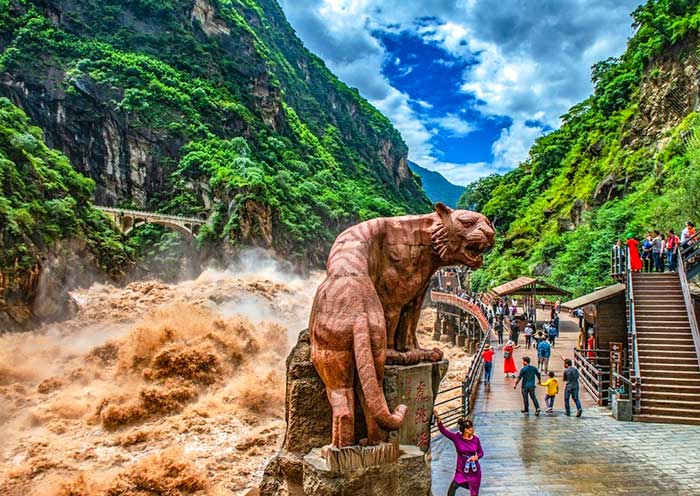
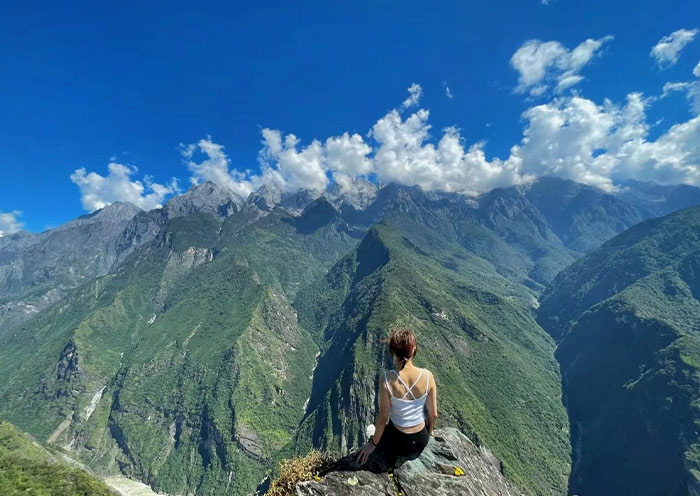
Tiger Leaping Gorge, or Tiger Leaping Gorge Scenic Area, is a breathtaking canyon located on the Jinsha River, a tributary of the Yangtze River, in Yunnan. It is one of the deepest and most spectacular river canyons in the world, attracting nature enthusiasts and adventure seekers. It is located on the halfway from Lijiang to Shangri-La, with a distance of 70 kilometers north of Lijiang city center and 90 kilometers south of Shangri-La city.
The gorge gets its name from a local legend that tells the story of a tiger that leaped across the narrowest point of the gorge to escape from hunters. The dramatic scenery and rugged terrain make it a popular destination for hiking and trekking.
The Tiger Leaping Gorge is divided into the upper, middle and lower sections. The upper gorge is wider and more accessible, offering a different perspective of the canyon. The middle and lower gorge are narrower and steeper, with dramatic cliffs rising on both sides.
Hiking Trails in Tiger Leaping Gorge - Famous High Trail
Tiger Leaping Gorge offers several hiking trails that cater to different levels of fitness and time constraints. The most popular and scenic trek is the High Trail, which follows the upper edge of the gorge and provides stunning views of the river, waterfalls, and towering cliffs.
The High Trail is a one-way trek, typically taking 1-2 days to complete. The total distance is around 16 kilometers, with an elevation gain of about 1900 meters. The High Trail traverses the cliffs of the gorge, providing panoramic views of the Jinsha River snaking through the depths.
Check Yunnan Hiking Trails to find more details about the famous Tiger Leaping Gorge hiking.
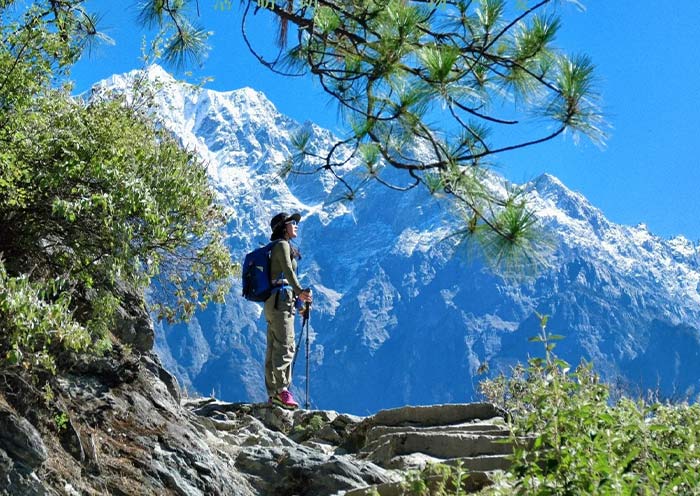
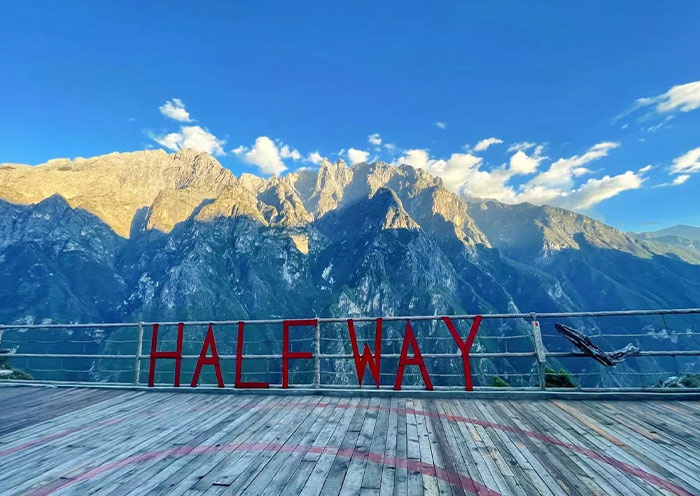
Other Highlights of Tiger Leaping Gorge
- Tiger Leaping Stone: One of the highlights of the gorge is the Tiger Leaping Stone, a large rock in the middle of the river that allegedly marks the spot where the tiger made its legendary leap. Visitors can catch a glimpse of the stone from the viewing platforms.
- Rapids and Waterfalls: The Jinsha River rushes through the gorge, creating turbulent rapids and cascading waterfalls along the way. The most famous waterfall is the 24-Eyed Waterfall, named for the numerous small falls that form a curtain of water.
- Naxi Minority Villages: The area surrounding Tiger Leaping Gorge is inhabited by the Naxi ethnic minority. Along the hiking trails, You can encounter traditional Naxi villages, where you can experience the local culture, interact with the friendly residents, and sample local cuisine.
5. Shangri-La Grand Canyon Balagezong (巴拉格宗)
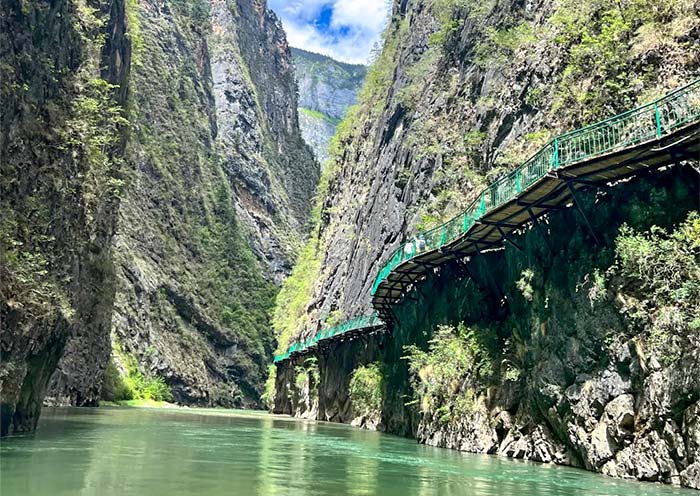
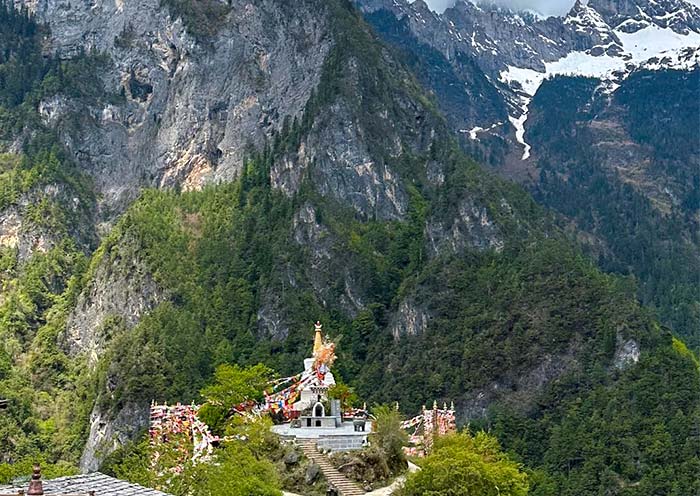
The Shangri-La Grand Canyon, also known as Balagezong, is a spectacular natural wonder situated near the town of Shangri-La in Yunnan Province, China. It forms part of the Three Parallel Rivers World Natural Heritage Site. Located approximately 90 kilometers from downtown Shangri-La, the journey to Balagezong takes around 2 hours by car.
Highlights of Balagezong
- Shangri-La Grand Canyon 香格里拉大峡谷
This deep canyon, formed between high mountains, is the lowest area of the scenic area at an altitude of 2,200 meters. You can walk along a wooden plank road for 2.7 kilometers to reach the endpoint and then return the same way, or choose to take a rubber raft back for an additional fee of 120 yuan per person.
- Bala Village 巴拉村
Located on the cliffside halfway up the mountain, Bala Village is a Tibetan village situated at an altitude of 3,600 meters. To reach the village, one needs to navigate through winding mountain roads, so those prone to motion sickness should be cautious. From Bala Village, you can enjoy the magnificent view of Gegong Snow Mountain 格宗雪山 across from the village.
- Huiyinbi (Echo Wall) 回音壁
Only a 5-minute drive from Bala Village, this attraction offers a 1-kilometer hike to reach the highest vertical distance glass plank road in China. Afterward, you can either return the same way or opt to take a 48-second high-altitude zip line back for an additional fee of 120 yuan per person.
- Xiangbala Pagoda 香巴拉佛塔
Shaped like a pagoda, this mountain is the highest viewpoint in the scenic area, situated at an altitude of 4,200 meters. It takes a 1-hour car ride from Bala Village. As the elevation increases, you may experience altitude sickness or discomfort.
6. Napahai Lake - Slow Life on Plateau
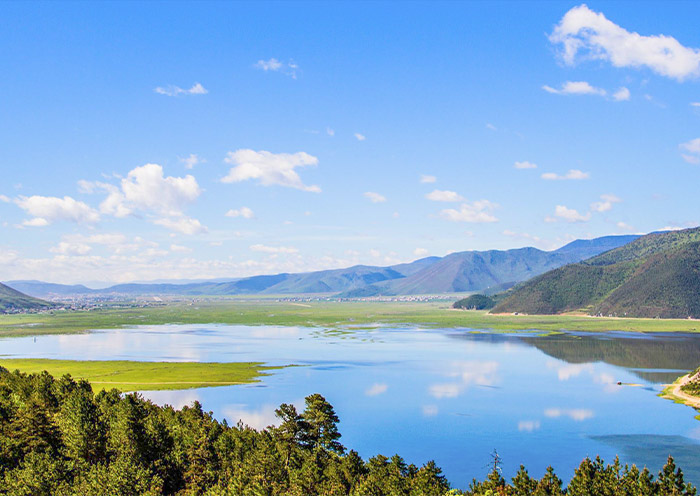
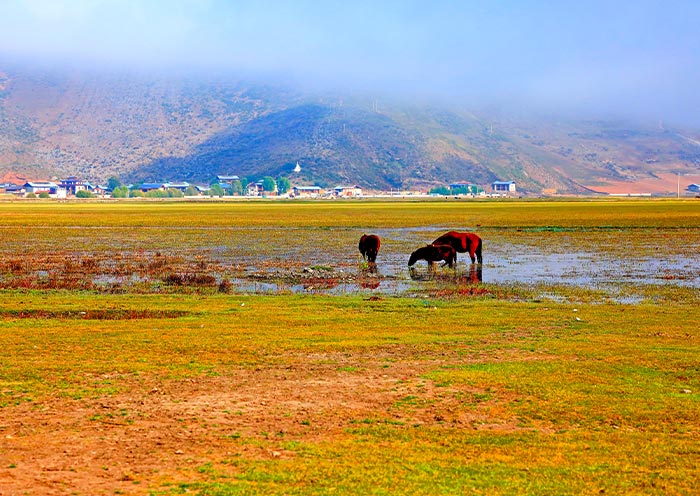
Napahai Lake, also known as Napahai Nature Reserve, is a beautiful highland lake located 20 kilometers northeast of Shangri-La City. The lake is surrounded by snow-capped mountains, grasslands, and wetlands, creating a stunning natural landscape.
Napahai Lake is a seasonal lake in Shangri-La. In the rainy and snow-melting seasons (summer and early autumn), it turns into a large freshwater lake. However, during the dry season, it transforms into a vast grassland with scattered pools. This change has given rise to a fascinating attraction known as the Water Highway.
Water Highway is part of the scenic road that encircles the lake, located on the western side and spanning approximately 700 meters. In the dry season, the road remains above the water surface. But when the rainy season arrives, the road gets submerged under about 20 centimeters of water. Despite this, vehicles can still drive through it, providing visitors with a unique experience of driving on water.
Things to Do in Napahai Lake
- Horseback Riding on Yila Grassland: Explore the picturesque Yila Grassland surrounding Napahai Lake on horseback. This vast grassland offers stunning views, and riding through it allows you to immerse yourself in the natural beauty of the area.
- Experience the Water Highway during the rainy season: During the rainy season, when the water levels rise, take the opportunity to experience the unique sensation of driving on the Water Highway. This submerged road provides a thrilling adventure and a different perspective of Napahai Lake.
- Birdwatching: Napahai Lake is a haven for birdwatchers. The lake attracts various bird species, including migratory birds. Grab your binoculars and observe the diverse avian life that inhabits the lake and its surroundings.
7. Meili Snow Mountain - Pyramid-Like Snow Peak
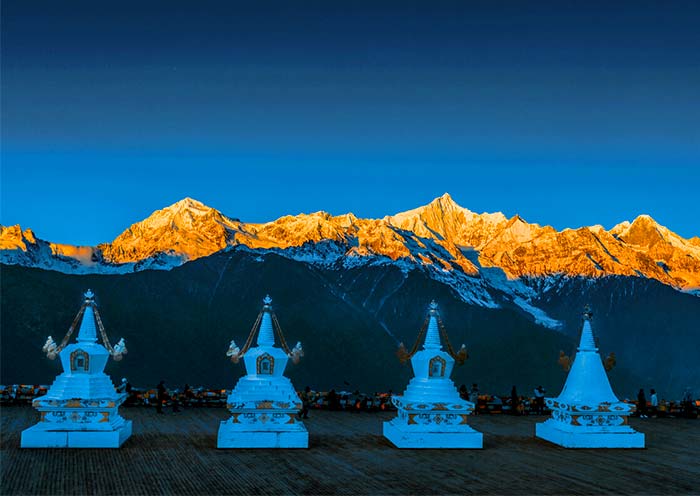
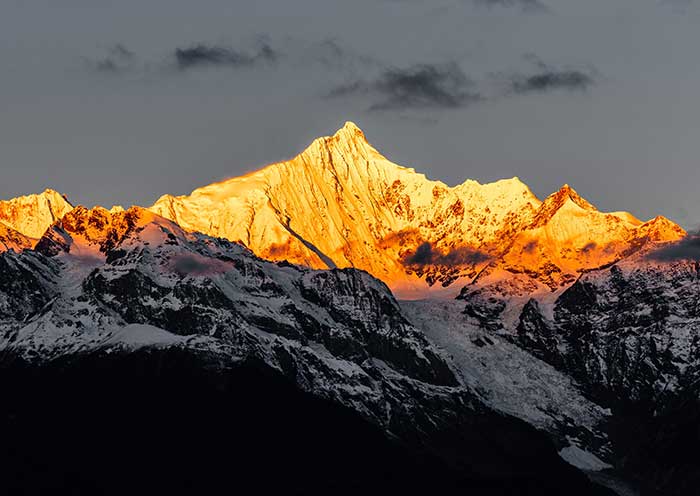
Meili Snow Mountain is a majestic mountain range located in the Yunnan Province of southwestern China, close to the border with Tibet. The range boasts 13 peaks exceeding 6,000 meters in height, with Kawagebo, the highest peak reaching a staggering 6,740 meters, making it the highest mountain in Yunnan.
The Meili Snow Mountains are considered one of the most sacred mountains in Tibetan Buddhism. The main peak, Kawagebo (also known as Meili Xueshan), is revered as the "God of Snow Mountain" and a place of pilgrimage for Tibetan people. Its pyramid-like peak makes people believe that the Shangri-La described in James Hilton's novel Lost Horizon is real.
Highlights of Meili Snow Mountain
Witness the Golden Sunrise: One of the most captivating experiences is witnessing the sunrise over the snow-capped peaks. The golden light illuminating the mountains creates a breathtaking spectacle.
Trekking and Hiking: For adventurous souls, the Meili Snow Mountains offer challenging yet rewarding trekking and hiking trails. Immerse yourself in the stunning scenery and connect with the region's natural beauty.
Visit Feilai Si (Flying Temple): Feilai Si is a Buddhist temple located at the base of Meili Snow Mountain. The temple is perched on a cliff and offers panoramic views of the surrounding peaks and valleys.
Marvel at the Mingyong Glacier: The Mingyong Glacier is one of the lowest-altitude glaciers in China and can be reached by hiking from the village of Feilai Si. The glacier offers breathtaking views of ice formations, deep crevasses, and glacial lakes.
8. Yubeng Village - Hiking Paradise under Snow Mountains
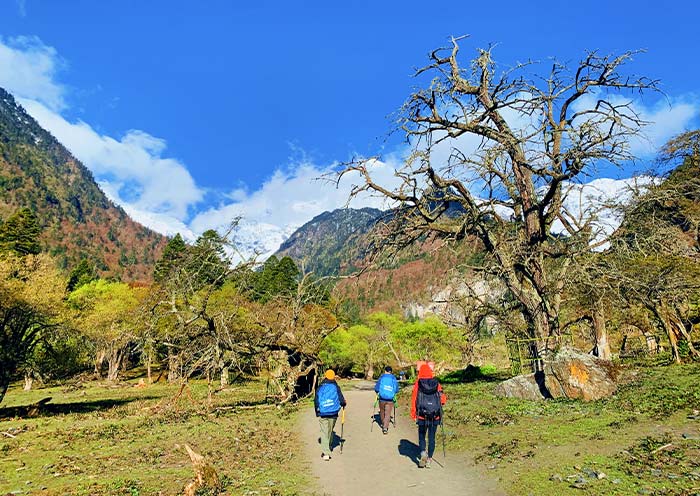
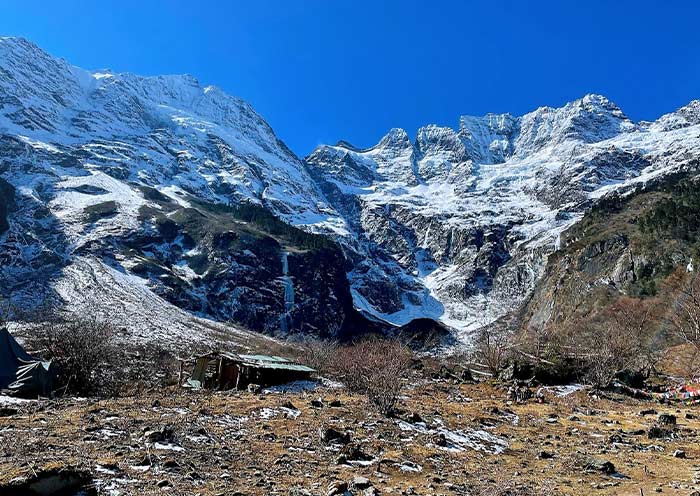
Yubeng Village is a remote and picturesque Tibetan village located in the valleys of Meili Snow Mountain. It is renowned for its pristine natural beauty, traditional Tibetan culture, and as a starting point for treks in the area. Yubeng Village is surrounded by stunning natural landscapes, including snow-capped peaks, lush forests, cascading waterfalls, and alpine meadows. The village itself is nestled in a valley, offering breathtaking views at every turn. The serene and untouched beauty of the area makes it a paradise for nature lovers and photographers.
Trekking in Yubeng Village
This is one of the most popular trekking routes in the area, offering a captivating journey through diverse terrain. The trek typically takes two days, starting from Yubeng Village and leading to the Sacred Waterfall and Glacier. Along the way, you will pass through dense forests, cross suspension bridges, and witness the beauty of alpine meadows. The highlight of the trek is reaching the magnificent Sacred Waterfall, which cascades down from the snow-capped peaks. You can also catch glimpses of glaciers and snow-covered mountains during the trek.
Trekking in Yubeng Village is an adventure that combines stunning natural beauty, cultural immersion, and physical challenge. It allows you to disconnect from the modern world, appreciate the grandeur of the mountains, and experience the unique Tibetan way of life.
Check more details about Yubeng Village trekking in Popular Yunnan Hiking Trails.
9. The Great Bend of Jinsha River

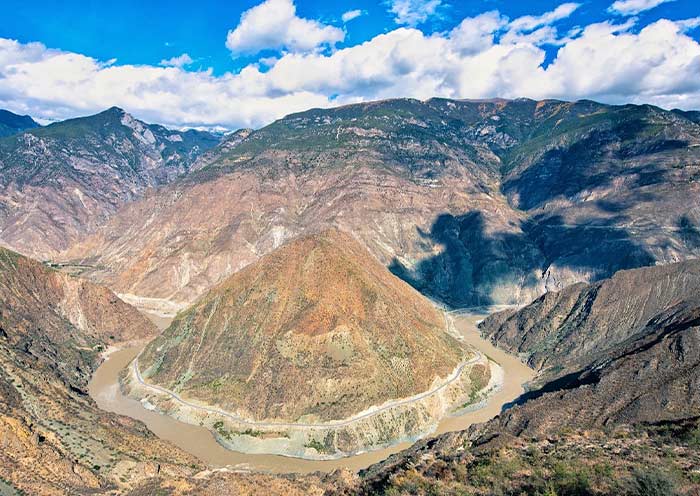
The Great Bend of Jinsha River, also known as Jinsha River Canyon, is a truly breathtaking natural wonder located in the Meili Snow Mountain National Park in Yunnan, about 130 kilometers south of Shangri-La. The bend is also sometimes referred to as the "Moon Bay" or the "Moon-shaped Bend of Jinsha River" due to its crescent-like shape.
The Jinsha River, the upper section of the Yangtze River, makes a dramatic U-turn here, forming a horseshoe shape. The bend is almost 180 degrees, creating a visually stunning and unique sight.
While the bend itself is not technically a canyon, the surrounding area features deep gorges and steep cliffs carved by the river over time. This creates a dramatic canyon-like landscape, further enhancing the visual impact of the bend.
How to Plan a Shangri-La Tour with Top Attractions (Shangri-La Itinerary)
Among the popular attractions in Shangri-La, Dukezong Ancient Town, Songzanlin Monastery, Napahai, and Pudacuo National Park are all within a close distance to the city and can be explored within a 2-day timeframe. Tiger Leaping Gorge, located on the way from Lijiang to Shangri-La, can be visited in half a day, but if you decide to hike the route, it would require 2 days. Meili Snow Mountain, Yubeng Village, and the Great Bend of the Jinsha River are part of the scenic route around Meili Snow Mountain National Park. A round trip from Shangri-La to these destinations would take 2 days, but if you include the Yubeng Village hike, it would require 4 days. Here are recommended popular Shangri-La itineraries:
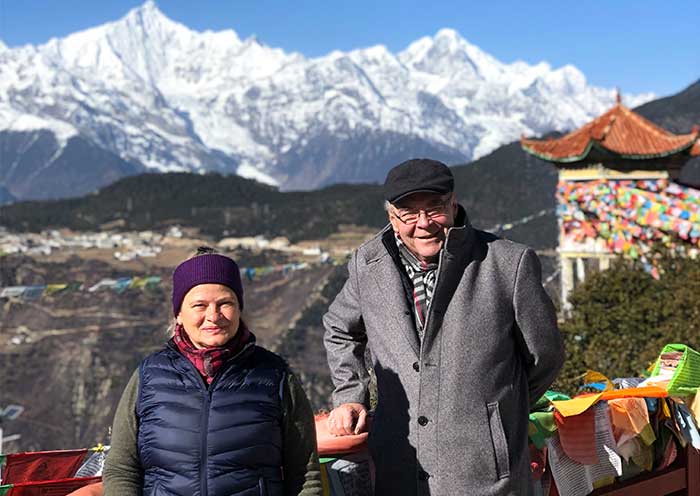

Classic 3-Day Itinerary from Lijiang
| Days | Routes | Highlights |
|---|---|---|
| Day 1 | Lijiang to Shangri-La | Tiger Leaping Gorge (Upper Gorge), Dukezong Ancient Town |
| Day 2 | Shangri-La City Sightseeing | Songzanglin Monastery, Potatso National Park (or Napahai Lake) |
| Day 3 | Shangri-La to Bagelazong | Shangri-La Grand Canyon, Huiyinbi () |
| Day 4 | Depart |
4-Day Itinerary with Meili Snow Mountain from Lijiang
| Days | Routes | Highlights |
|---|---|---|
| Day 1 | Lijiang to Shangri-La | Tiger Leaping Gorge (Upper Gorge), Dukezong Ancient Town |
| Day 2 | Shangri-La to Flying Temple | Songzanglin Monastery, Great Bend of Jinsha River, Flying Temple |
| Day 3 | Back to Shangri-La | Sunrise of Meili Snow Mountain, Napahai Lake |
| Day 4 | Depart |
5- Day Yubeng Village Trekking Itinerary
| Days | Routes | Highlights |
|---|---|---|
| Day 1 | Shangri-La to Flying Temple | Songzanglin Monastery, Great Bend of Jinsha River, Flying Temple |
| Day 2 | Trek to Sacred Waterfall | Sunrise of Meili Snow Mountain, Yubeng Village, Sacred Waterfall |
| Day 3 | Trek to Ice Lake | Ice Lake, Glacier |
| Day 4 | Trek to Ninong Bridge and return Shangri-La | Meili Snow Mountain |
| Day 5 | Departure |
Travel with Asia Odyssey Travel (AOT) to Explore Shangri-La, Yunnan
Travel to Shangri-La with Asia Odyssey Travel (AOT) and indulge yourself in the enchanting beauty and vibrant culture of Yunnan. With over a decade of experience in the region, AOT is a trusted travel partner that provides a variety of customizable Shangri-La tour packages, catering to the preferences of every traveler. Whether you're looking for a scenic explore, a snow mountain adventure, or a cultural exploration of Shangri-la and its Tibetan minority heritage, AOT has the expertise to curate the perfect itinerary for your needs. Immerse yourself in the wonders of Shangri-La with AOT and create unforgettable memories in this captivating destination.
Popular Attractions: Tiger Leaping Gorge, Songzanling Monastery, Pudacuo National Park, Dukezong Ancient Town, Meili Snow Mountain
Tour Packages: Shangri-La Tours, Lijiang Shangri-La Tours, Tiger Leaping Gorge Tours
Embark on an extraordinary adventure with Asia Odyssey Travel and explore the beauty, culture, and warm hospitality of Shangri-La. Contact us today to start planning your dream vacation.
